Part 2 - The pollination of guembé
by Ghillean Prance and Hector Keller
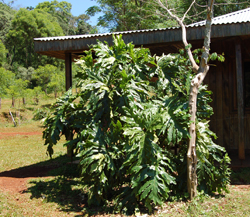 The initiation of flowering in guembé is one of several signals from nature to the Guaraní that the cold season has ended and it is time to plant. This is exactly the time we were last with them and so guembé was beginning to come into flower. There happened to be a large plant right beside the field-station where we were staying and we noted in the evening that beetles were coming to the flower.
The initiation of flowering in guembé is one of several signals from nature to the Guaraní that the cold season has ended and it is time to plant. This is exactly the time we were last with them and so guembé was beginning to come into flower. There happened to be a large plant right beside the field-station where we were staying and we noted in the evening that beetles were coming to the flower.
Like all members of the aroid family the inflorescence of guembé consists of a spadix bearing the flowers enclosed by a leaf-like sheath called a spathe. The spadix of most aroids have the male and female flowers separate from each other and in guembé the female flowers are borne at the base of the spadix with the pollen bearing male flowers above. While in bud the flowers of guembé are tightly wrapped up by the protective spathe.
Once the inflorescence is mature one evening, as darkness approaches, the leathery and protective spathe will open up and the pure white spadix is prominently exerted outside like a flag to attract the pollinators. It is well known that in many aroids the temperature inside the opening flowers is elevated. For example the skunk cabbage of the forests of North America often comes into flower while there is still snow on the ground and the heat from the flower will melt the nearby snow. This change in temperature also occurs in guembé where the temperature rises as the flower opens and this is followed by the emission of a strong anise-like perfume. We measured the temperature inside the inflorescence and recorded it regularly. The maximum difference between the ambient temperature and the flower we found was 13°C.
Once the inflorescence opens up scarab beetles (Erioselis emarginata) begin to arrive and they immediately make their way down into the base where the female flowers are located. If the beetles have previously visited another inflorescence the pollen on their bodies rubs off onto the female flowers and pollination takes place. As this is occurring the spathe closes up again and so the beetles become trapped inside. They remain in this cosy warm home until the next evening when the spathe partially opens up and the stamens emit their pollen. The beetles come up the chamber to the male flowers and graze on the pollen becoming covered with pollen. The beetles gradually work their way to the top of the spadix and emerge from the inflorescence coated with pollen.
They then take off and fly directly to another first day inflorescence. Since only one inflorescence on a plant opens at any time the beetles will go to a different individual and thus cause cross-pollinate. The delicious fruit that the Guaraní so enjoy is dependent on the work of scarab beetles to carry out this remarkable act of fertilisation.
Many other beetle pollinated flowers exhibit the phenomenon of thermogenesis or heating of the flowers as they open and this is connected to the emission of the strong odour needed to attract the beetles. Another plant with elevated flower temperature that one of us (GTP) has studied in detail is the royal water lily (Victoria amazonica), which is pollinated by a different species of scarab in the Amazon.
Close-up photographs by Prof. Prance and Dr. Keller of the fascinating pollination process
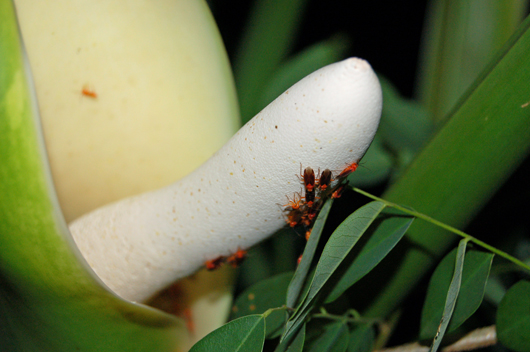
The phallic-like spathe of a first day flower of guembé. On the first day it sticks right out of the flower to attract the beetles. Note the insects visible here are small flies and not the pollinator beetles.
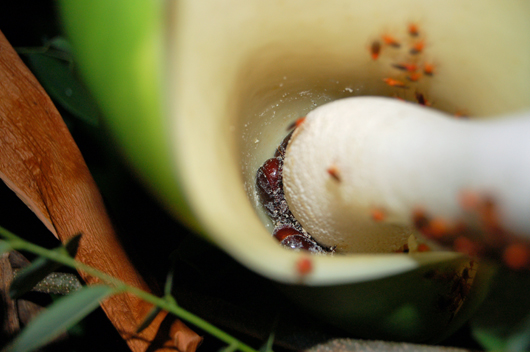
Beetles at the base of the inflorescence where they come into contact with the female flowers of guembé.
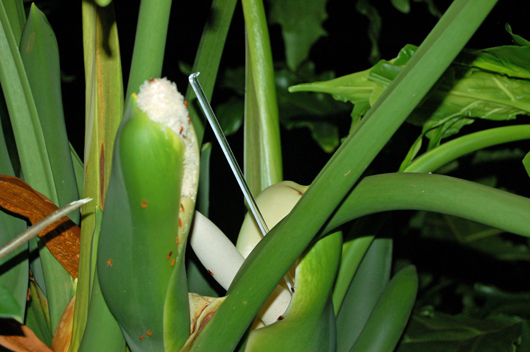
First and second day flowers next to each other. In front is the closed second day flower with beetles trapped inside and behind is an open second day flower with thermometer to measure flower temperature.
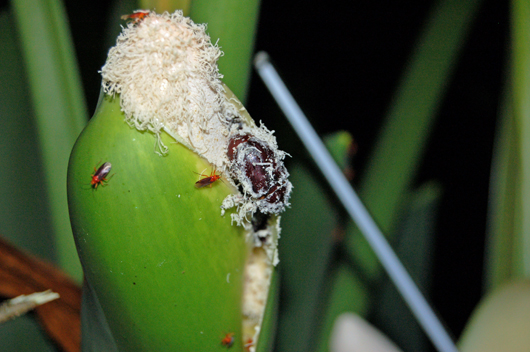
Scarab beetles (Erioselis emarginata) emerge from a second day flower of guembé.
They are well dusted with pollen!